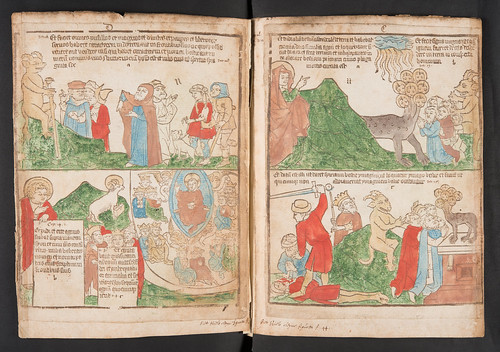Biblia. N. T. Apocalypse. [Latin]
Xylographic blockbook.
[Netherlands or Germany: mid-1460s]. The date refers to the cutting of the blocks.
Folio. [1-252]. [50] leaves. Printed in brown ink.
Schreiber, Manuel, IV, pp. 160-216; Bod-inc BB-1; CIBN AA-1; R. Donaldson, ‘Two block-books in the Hunterian Library, University of Glasgow’, The Bibliotheck, 3 (1961), pp. 103-4.
‘Schreiber distinguishes six editions of the blockbook [Apocalypse], of which I and II, being printed from the same blocks, are better described as two states of a single edition I/II’ - Nigel F. Palmer, Bod-Inc BB-1. The Glasgow copy is edition I/II state II. ‘A complete copy of edition I/II state II has 50 leaves, all with woodcuts and xylographic text printed on one side of the paper ... Each plate appears to have been engraved on an individual block, with the grain running vertically, and printed in pairs. Pairs of signatures, consisting of the letters a, a (repeated), b-u, x-y, +, and ×, have been added in the upper register on the facing pages of every bifolium.’ - Palmer.
| GIP number: | B70 |
| Shelf-mark: | Sp Coll Hunterian Ds.2.3 (see main library entry for this item) |
| Note: | The order of the plates in this copy is (in Schreiber’s numbering): 1-7, 12-18, 25, 26, 19, 23, 27-32, 35-36, 33-34, 37-50. |
| Provenance: | Anthony Askew (1722-1774), physician and classical scholar: source unknown; Askew sale, 13 Feb. 1775 onwards; lot 1936 in Bibliotheca Askeviana ... (London: Baker & Leigh, 1775); this copy was in Askew’s library at least from 1756, at which point it was examined by Gerard Meerman - see the latter’s Origines typographicae (1765), vol. 1, p. 238, footnote (bq) “Hoc ipse in utroque itinere meo Anglicano a. 1756. et 1759. in eius bibliotheca vidi”. William Hunter (1718-1783), physician and anatomist: purchased by Hunter at the Askew sale for £21.0.0 according to the partially annotated copy of the Askew sale catalogue in Glasgow University Library (shelfmark Mu36-c.8). University of Glasgow: Hunterian bequest 1807; Hunterian Museum bookplate on front pastedown, with former shelfmark “K.2.8”. |
| Binding: | England, 18th-century undecorated, diced russia; according to a pencil note on verso of rear free endpaper the volume was repaired and rebacked 28 Apr. 1936, and given a gold-tooled goatskin spine covering; 18th-century marbled endpapers; two rear flyleaves have watermark of a shield containing a fleur-de-lys, surmounted by a crown and with the letters “L V G” suspended below - for a similar watermark, that of James Whatman, the Elder, see Alfred H. Shorter, Paper mills and paper makers in England, 1495-1800 (Hilversum: 1957) fig. 180, p. 368; all leaves mounted and attached to guards. Size: 327 x 252 mm. |
| Leaf size: | Plate 1 (excluding mount): 292 x 214 mm. Plate 1 (block frame): 266 x 204 mm. Plate 1 (including mount): 314 x 215 mm. |
| Annotations: | On several leaves biblical chapter and verse numbers are written in ink in an early hand close to the woodcut text or in the margin of the mounts; in some instances the separate portions of text have been assigned lower case letters of the alphabet; each plate has been assigned a letter (or letters) of the alphabet written in ink in a different early hand in the middle of the top margin above the woodcut frame, as follows (using Schreiber’s numbering): 1 (A), 2 (B), 3 (C), 4 (D), 5 (E), 6 (F), 7 (G), 12 (L), 13 (N), 14 (O), 15 (P), 16 (Q), 17 (R), 18 (S), 25 (a), 26 (b), 19(Q), 23 (X), 27 (d), 28 (e), 29 (Gg), 30 (h), 31 (i), 32 (k), 35 (Nn), 36 (O), 33 (Ll), 34 (m), 37 (O), 38 (P), 39 (Rr), 40 (Sſ), 41 (Qq), 42 (Tt), 43 (E), 44 (F), 45 (Y), 46 (Xx), 47 (Z), 48 (z), 49 (no letter), 50 (no letter); references in Dutch in a 17th-century hand on the mounts of plates 27, 28, and 29 to ‘Hiels Figuren’ i.e. the Imagines et figurae Bibliorum (1582) of Hendrik Jansen van Barrefelt, known as ‘Hiël’; several mounts numbered in a 16th-century hand in extreme outer corners – the numbering parallels Schreiber’s enumeration; tipped onto the first front flyleaf are 19th-century notes on copies of the blockbook Apocalypse taken from Thomas Hartwell Horne’s An introduction to the study of bibliography (1814), together with notes on the Biblia Pauperum; on the second front flyleaf are notes by Anthony Askew with references to Samuel Palmer, The general history of printing (1732), Claude Gros de Boze, Catalogue des livres du cabinet de M. de Boze (1745), and Gerard Meerman, Origines typographicae (1765), which are followed by notes by William Hunter in which he discusses the theory that blockbooks may have their origin in the stamping of wood-engraved playing cards; also tipped-in at the front are several pages of notes on the Hunterian copy of the Apocalypse written by Professor John Young, Keeper of the Hunterian Museum and Library, 1866-1902 |
| Decoration: | Woodcuts hand-coloured in dark red, dark green, pale blue, buff, grey, beige, and reddish purple. |
| Imperfections: | Wanting plates 8-11, 20-22 and 24 of Schreiber’s enumeration. |






